It is important for architects to fully understand the definitions of (and procedures for measuring) building floor areas. Building area square footage calculations done by the architect are often used to set rental rates or negotiate zoning variances so maintaining precise measurements is critical. Errors could cost your client a significant sum of money.
Unfortunately, definitions for building areas vary around the world. Since different codes, standards, and jurisdictions each use their own definitions for area measurements, it is critically important that the architect confirm what standard of measurement should be used. It is advisable to review the definitions before each measurement exercise since they can be similar and easily confused.
- Building Area
- Gross Floor Area
- Net Floor Area
- Building Gross Square Feet
- Construction Gross Area (deprecated)
- BOMA Gross Area 4 - Construction Method
- Exterior Gross Area (deprecated)
- BOMA Gross Area 1 - Leasing Method
- BOMA Gross Area 2 and Gross Area 3
- Gross Measured Area (deprecated)
- Boundary Area
- Usable Area
- Rentable Area
- Net Assignable Area
- Zoning Floor Area
In addition to building codes like the International Building Code, there are a couple of other recognized standards for measuring buildings in North America:
BOMA: The Building Owners and Managers Association has been publishing standards for measuring building areas since 1915. BOMA Standards are most commonly used for buildings that are leased to tenants. They have specific standards for office, industrial, multi-unit residential, retail, and mixed use buildings. BOMA standards adhere to ANSI processes. They are available for purchase from Amazon or directly from the BOMA website.
FICM: The National Center for Education Statistics publishes their Facilities Inventory and Classification Manual, which is most often used as the standard for measuring post-secondary educational buildings. The FICM is available as a free PDF download.
IFMA: The International Facility Manager’s Association publishes the Standard Classification for Building Floor Area Measurements for Facility Management. The standards are incorporated under ASTM E1836.
There are a number of building area definitions that architects should be familiar with. As mentioned earlier, you should confirm what definition should be used for the specific purpose you are undertaking. The following area definitions are commonly used in North America.
It is important to note that different parties will calculate different areas of the exact same building even if they use the exact same method. This is normal and expected due to the complexity of running the calculations. Square footages are considered accurate when the discrepancy between two calculations is less than 2%.
Building Area
Building Area is defined by building codes and is the allowable size of the building based on fire hazard and type of construction. The measurement should not be used in lease agreements or for calculating rent payments. Always be sure to check your local code for the proper definition in your jurisdiction.
According to the 2018 International Building Code, Building Area is defined as:
The area included within surrounding exterior walls, or exterior and fire walls, exclusive of vent shafts and courts. Areas of the building not provided with surrounding walls shall be included in the building area if such areas are included within the horizontal projection of the roof or floor above.
Building Area is the footprint of the building measured to the inside face of the exterior walls. All enclosed spaces are included and deductions are not made for mechanical shafts, vertical circulation, interior walls, or structural elements. Internal courtyards that are open to the sky above are excluded from Building Area.
Gross Floor Area (GFA)
Gross Floor Area is used to calculate occupant load and is a sum of all occupiable and nonoccupiable spaces for a given area. It may also include exterior covered spaces that are part of the building's occupiable space. Gross Floor Area is not used for lease agreements.
The Gross Floor Area is defined by the 2018 International Building Code as:
The floor area within the inside perimeter of the exterior walls of the building under consideration, exclusive of vent shafts and courts, without deduction for corridors, stairways, ramps, closets, the thickness of interior walls, columns or other features. The floor area of a building, or portion thereof, not provided with surrounding exterior walls shall be the usable area under the horizontal projection of the roof or floor above. The gross floor area shall not include shafts with no openings or interior courts.
Other codes, including local building codes, may have a different definition. For instance, the 2015 edition of NFPA 101: Life Safety Code defines Gross Floor Area as:
The floor area within the inside perimeter of the outside walls of the building under consideration with no deductions for hallways, stairs, closets, thickness of interior walls, columns, elevator and building services shafts, or other features, but excluding floor openings associated with atriums and communicating spaces.
Net Floor Area (NFA)
Net floor area is used to calculate occupant load based on building codes. It is measured to the inside face of a room's walls. Net floor area does not include accessory areas as described below.
Net Floor Area is defined by the 2018 International Building Code as:
The actual occupied area not including unoccupied accessory areas such as corridors, stairways, ramps, toilet rooms, mechanical rooms and closets.
Building Gross Square Feet (BGSF)
Be sure to get clarification on the exact measurement methodology when a person asks for the Gross Square Footage of a building.
Building Gross Square Footage does not have a specific definition that can be referenced. It is used informally to determine construction costs or building value, usually by contractors. The measurement should not be used in lease agreements or for calculating rent payments. Do not confuse BGSF with Building Area (defined above), which is a code-based definition that limits the size of a building.
BGSF should also not be confused with other formalized definitions of Gross Area. BOMA has multiple definitions for Gross Area (see below); building codes reference Gross Floor Area; and other standards (FICM, IFMA, LEED, etc.) provide their own definitions.
Building Gross Square Footage is usually the area of construction to the outside face of the exterior walls. Covered areas like porches, terraces, and entry alcoves may be included, but not always. "Open to below" areas in multi-story voids (atria) are excluded from BGSF – only the first floor of a multi-story open space is included.
Construction Gross Area (CGA) - Deprecated
Construction Gross Area was deprecated in BOMA 2018 Gross Areas. It has been replaced by Gross Area 4 - Construction Method, which we describe below.
According to BOMA's Gross Areas of a Building: Standard Methods of Measurement, 2009, Construction Gross Area is defined as:
The total of all the horizontal floor areas (as viewed on a floor plan) of all floors of a building contained within their building perimeters excluding voids (except for occupant voids), interstitial space, roofs, unexcavated areas, crawl spaces, un-structured on-grade parking and other site improvements. Make no deductions for columns or any structural elements within the building perimeter.
CGA is a larger measure than Exterior Gross Area since it includes covered, but unenclosed, spaces that are considered to be within the building perimeter. It may be useful for defining construction cost or building value. CGA is very similar to Building Area, defined above.
BOMA Gross Area 4 - Construction Method
BOMA/ANSI Z65.3, Gross Area 4 replaces the previous Construction Gross Area (CGA) and is used for estimating construction costs or maintenance costs. It was introduced in ANSI/BOMA Z65.3-2018. Gross Area 4 represents the largest square footage calculation since it includes all areas.
The BOMA Gross Areas of a Building: Standard Methods of Measurement, 2018 identifies BOMA Gross Area 4 as the sum of all areas within the boundary lines of Space Classifications A, B, C, D, E, and F. This includes the following:
- Space Classification A: Floor Area, Parking Area, and Connectors
- Space Classification B: Balconies, Exclusive Use Covered Galleries, and Finished Rooftop Terraces
- Space Classification C: Unenclosed Occupant Circulation and Roofless Structured Parking
- Space Classification D: Public Use Covered Galleries and Sheltered Area (Industrial)
- Space Classification E: Building Voids
- Space Classification F: Other Rooftop Areas, Unenclosed Connectors, Decks, and Plazas
The following images depict Gross Area 4 for a simple building in cyan:
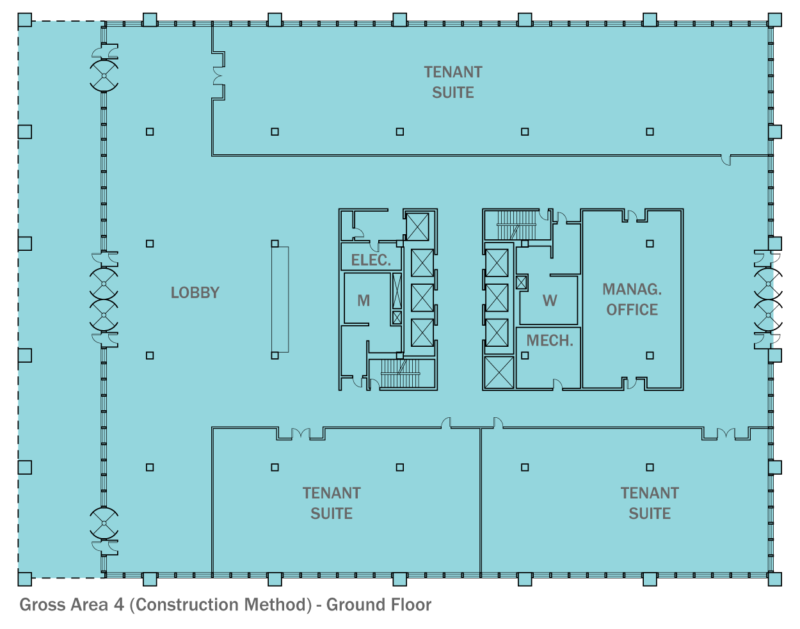
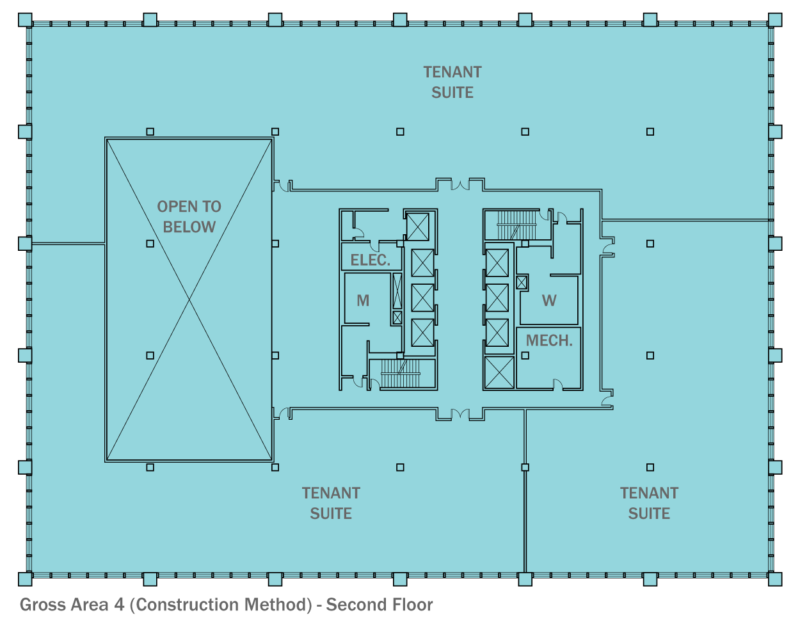
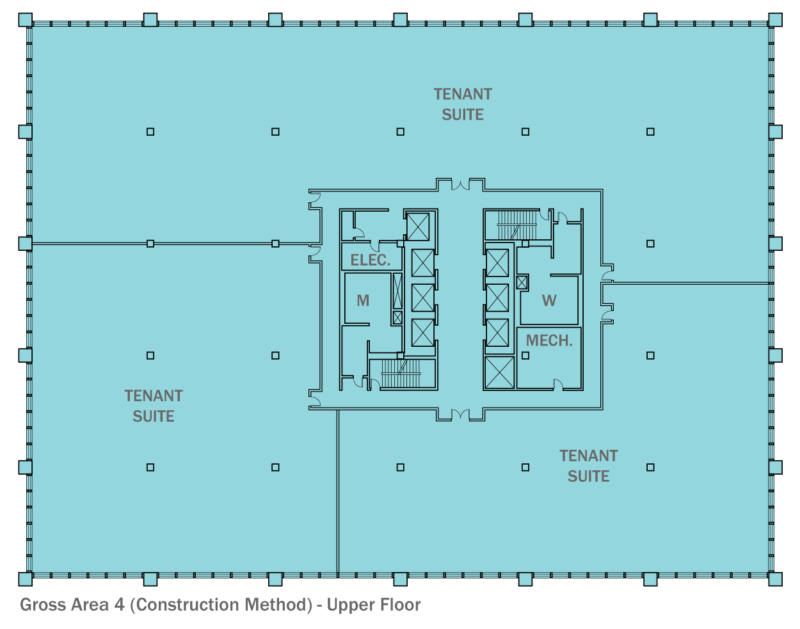
Exterior Gross Area (EGA) - Deprecated
Exterior Gross Area was deprecated in BOMA 2018 Gross Areas. It has been replaced by Gross Area 1 - Leasing Method.
According to BOMA's Gross Areas of a Building: Standard Methods of Measurement, 2009, Exterior Gross Area is defined as:
The total of all the horizontal floor areas (as viewed on a floor plan) of all floors of a building contained within their measure lines, excluding voids (with the exception of occupant voids), interstitial space, unexcavated space and crawl space. Make no deductions for columns or any structural elements within the measure line.
Unenclosed spaces (such as balconies, terraces, entry alcoves, roofs, and colonnades) are EXCLUDED from the Exterior Gross Area measurement. The EGA may be appropriate for use in zoning and Floor Area Ratio calculations.
Exterior Gross Area is also used by the IFMA, which defines EGA as:
The area of the floor measured to the outside face of the walls that enclose the floor(s) of the building.
BOMA Gross Area 1 - Leasing Method
BOMA/ANSI Z65.3, Gross Area 1 is similar to the previous Exterior Gross Area (EGA) and is used for calculating the gross area of a building that is leased to a single occupant. It was introduced in ANSI/BOMA Z65.3-2018.
BOMA's Gross Areas of a Building: Standard Methods of Measurement, 2018 defines BOMA Gross Area 1 as the sum of all areas within the boundary lines of Space Classifications A, B, and C. This includes the following:
- Space Classification A: Floor Area, Parking Area, and Connectors
- Space Classification B: Balconies, Exclusive Use Covered Galleries, and Finished Rooftop Terraces
- Space Classification C: Unenclosed Occupant Circulation and Roofless Structured Parking
The following images depict Gross Area 1 for a simple building in purple:
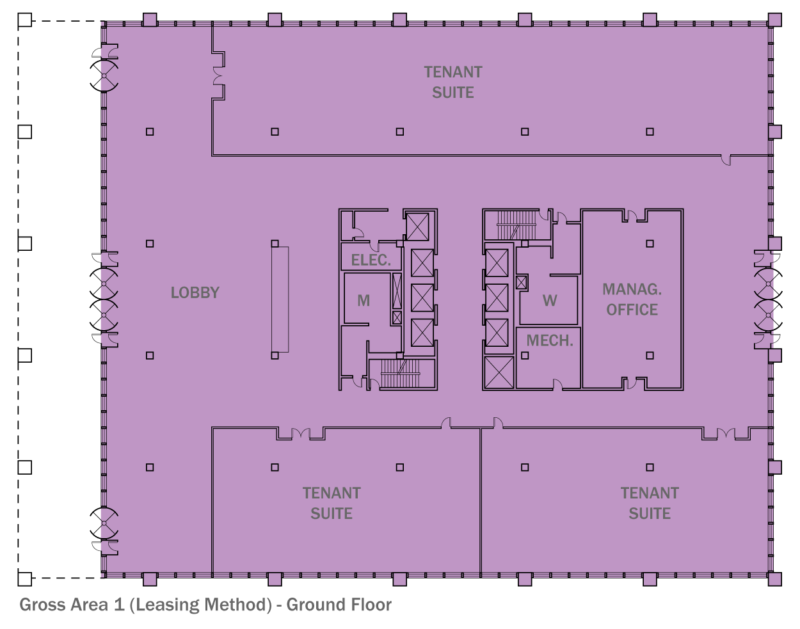
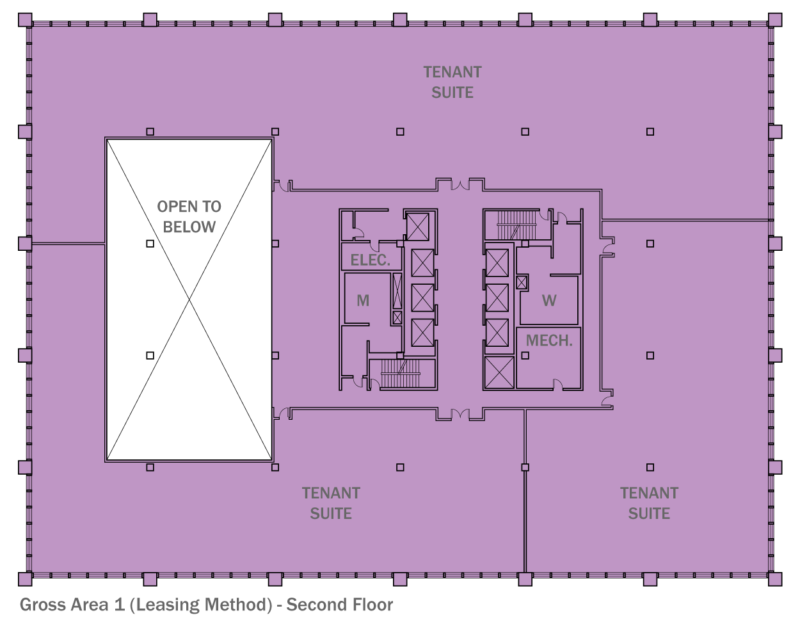
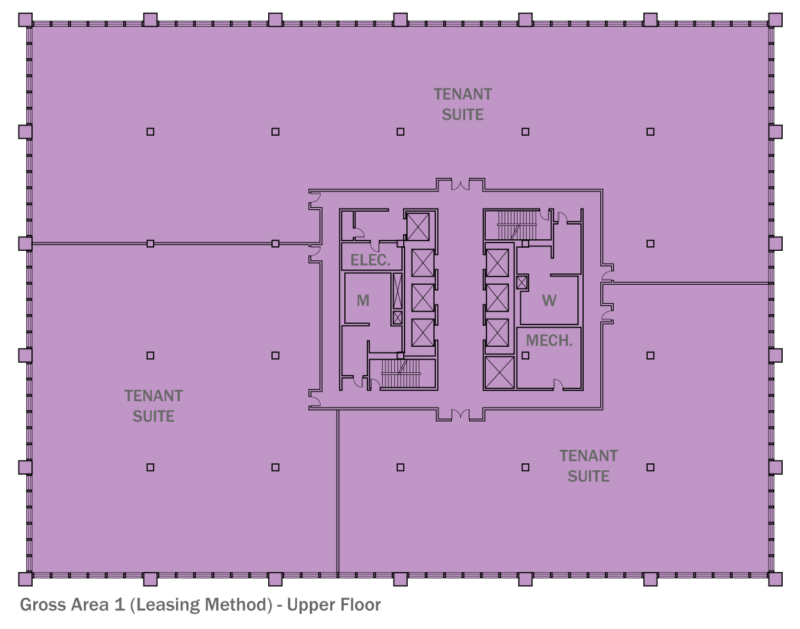
BOMA Gross Area 2 and Gross Area 3
BOMA/ANSI Z65.3, Gross Area 2 is the International Comparison Method, which is compliant with the International Property Measurement Standards. Space Classifications A, B, and D are included in the calculations.
BOMA/ANSI Z65.3, Gross Area 3 is called the Volumetric Method. It is used for design studies that analyze heat gain or other sustainability issue that require building volume. All interior spaces are included (Space Classifications A and E.)
Gross Measured Area - Deprecated
Gross Measured Area is an area measurement that was used in older versions of the BOMA Standards. Current versions of the standards no longer use this term.
The Gross Measured Area of a building is the total area of a building, calculated on a floor-by-floor basis, as measured to the "dominant portion" of an enclosing surface. It does not include spaces outside the building enclosure.
The dominant portion of an enclosing surface is the part of the wall that provides more than 50% of the finished wall between the finished floor and finished ceiling. For instance, curtain wall systems are often more than 50% glass so the measurement line in this case is the interior face of the glass. However in a building that has punched openings, the windows may only represent 30% of the wall surface so the dominant portion would be the interior face of the drywall. If there is no dominant portion, use the inside finished surface of the wall where it intersects the floor as the measuring line.
Boundary Area
Prior to BOMA 2017 for Office Buildings, Boundary Area was called Interior Gross Area (IGA). Interior Gross Area is deprecated by BOMA, but still used by the IFMA.
According to BOMA's Office Buildings: Standard Methods of Measurement, 2017:
Boundary Area is established by defining the area of each Floor in a Building according to the Boundary Conditions. The space inside the Boundary Area is the Floor Boundary Area and the total sum of all Floor Boundary Areas is the Building Boundary Area. The Boundary Area is adjusted along the perimeter of each Floor according the the rules outlined in the Boundary Conditions..."
In general, the Dominant Portion method is used to define the Boundary Area. There are a number of exceptions included in the BOMA Standards (external circulation, non-vertical walls, unprotected openings, and voids), but those are beyond the scope of this article. For more information, consult the BOMA Standards.
Interior Gross Area is still used by the IFMA and is defined as:
Portion of the floor(s) that is totally enclosed within the dominant portion.
Usable Area measured as Usable Square Feet (USF)
Usable Area is used in multiple standards, but in general, it is the portion of a floor or building classified as tenant areas and amenity areas. Service areas (restrooms, electrical closets, data closets, etc) are excluded from the measurement. Usable Area is always lower than Rentable Area.
In the BOMA Standards, Usable Area is used under Method A (the Legacy Method) for calculating Rentable Area. It is not used in Method B (Single Load Factor Method).
The following images depict Usable Gross Area in green:
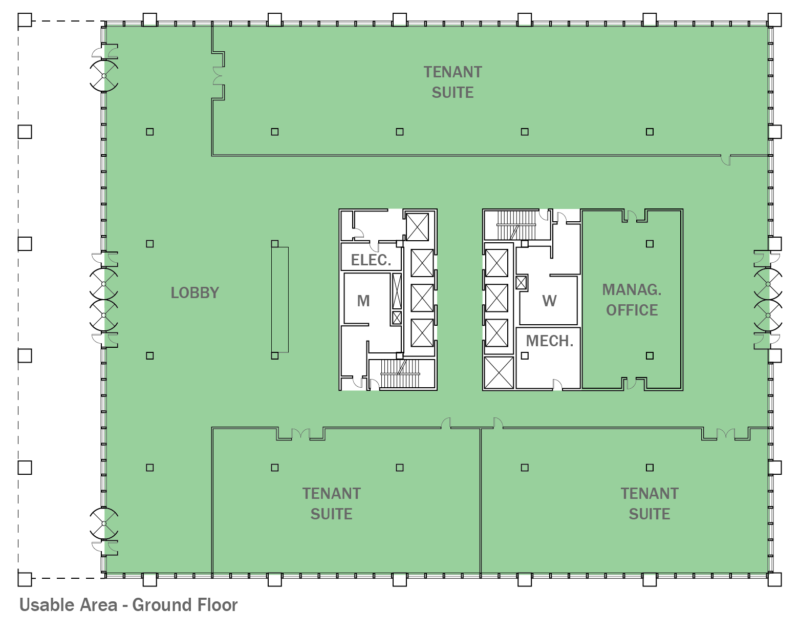
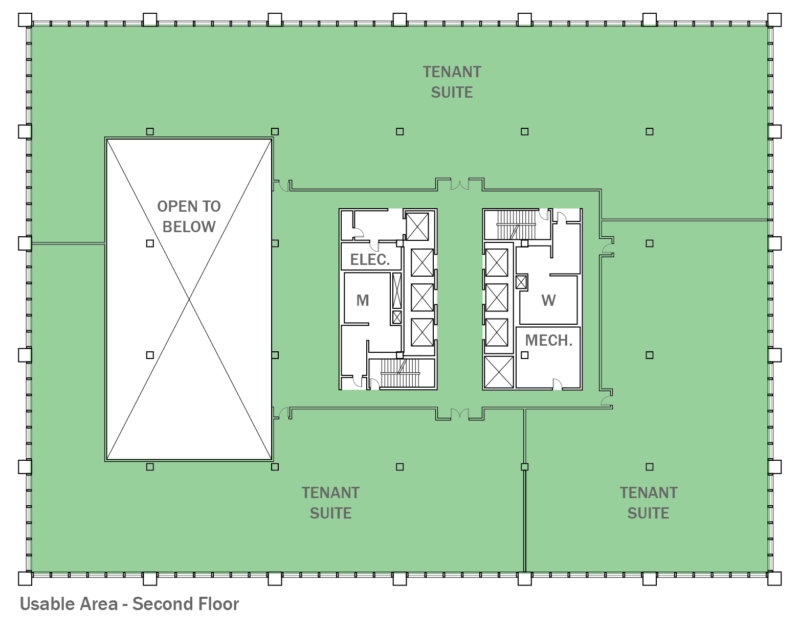

Rentable Area measured as Rentable Square Feet (RSF)
Rentable Area is a term used in the BOMA Standards to identify the portion of a floor or building for which a tenant will pay rent. It is loosely defined as the sum of the tenant's area and the tenants share of the common or shared spaces (amenity and service areas). Landlords may also calculate the Building Rentable Area to identify the income producing area of their building. In that case, the Building Rentable Area is the sum of the building usable area and all of the common spaces (amenity and service areas) that are shared by building occupants.
The BOMA Standards provide two methods of calculating Rentable Area. Only one method should be used throughout the entire building. In both methods, calculating the Rentable Area requires multiplying the total floor area by a ratio that represents the tenant's portion of the floor. The difference between the two methods is in the way the ratio is calculated. Discussion about selecting the correct method for calculating Rentable Area is beyond the scope of this article. For more information, refer to the BOMA Standards.
Other standards define Rentable Area differently so it is important to confirm the definition and calculation method with the building owner.
The following images depict Rentable Area. The blue area represents the occupant area and the pink area represents common spaces (circulation, amenity, and service areas). The sum of the blue and pink areas is equal to the Rentable Area:
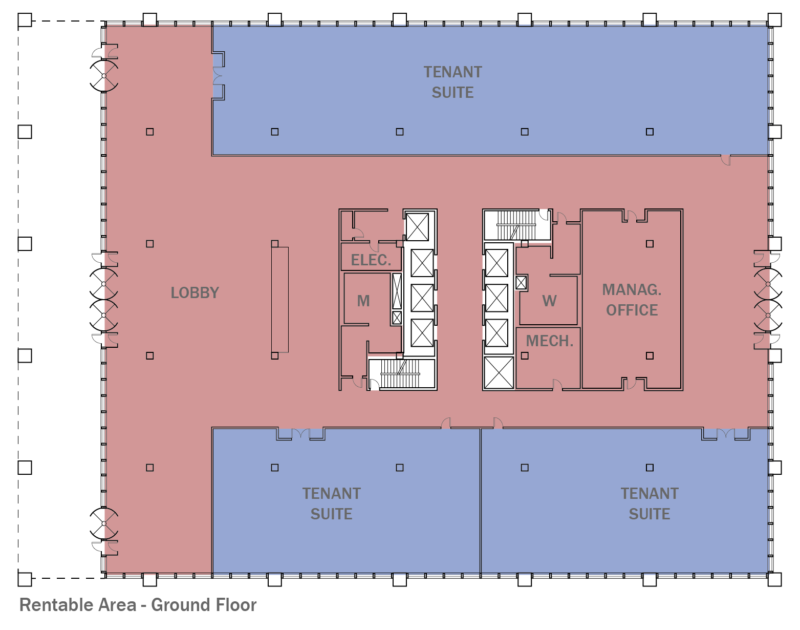

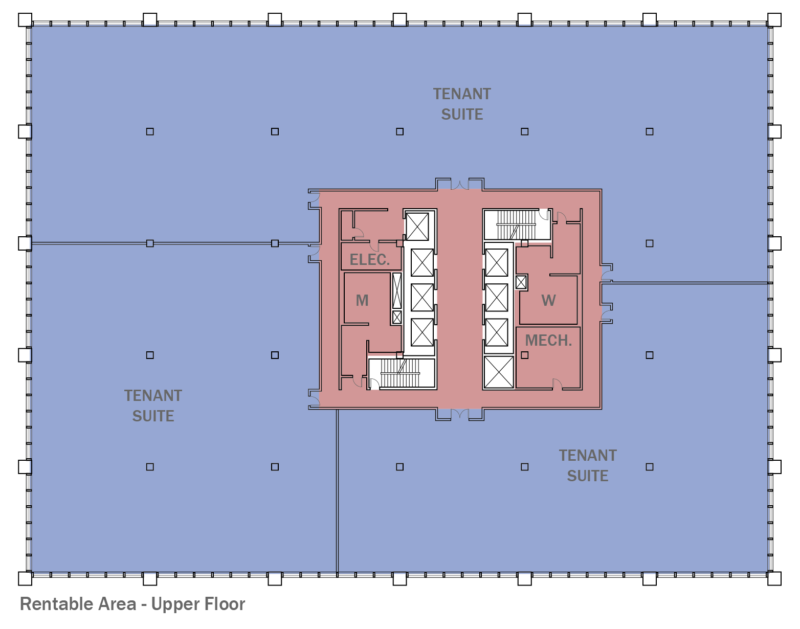
Net Assignable Area measured as Net Assignable Square Feet (NASF)
Net Assignable Area is used when calculating areas in post-secondary educational institutions (colleges, universities, related research buildings, etc.) using the FICM. Simply stated, NASF is the sum of spaces that can be assigned to people or programs within the ten major space use categories (classrooms, laboratories, offices, study areas, special use space, general use areas, support rooms, healthcare, residential, and unclassified space.) Excluded from NASF are the three non-assignable space categories (building service area, circulation area, and mechanical area) that are required for the operation of the building.
Net Assignable Area is measured to the inside face of each individual space, so wall thicknesses are excluded from the calculations – wall thicknesses are considered part of the Structural Area of the building or space.
Do not make deductions for structural columns or projections. It would take more effort than it is worth to exclude them from the calculations since these elements are such a small percentage of the overall space in the building.
The following images depict Net Assignable Area in purple:
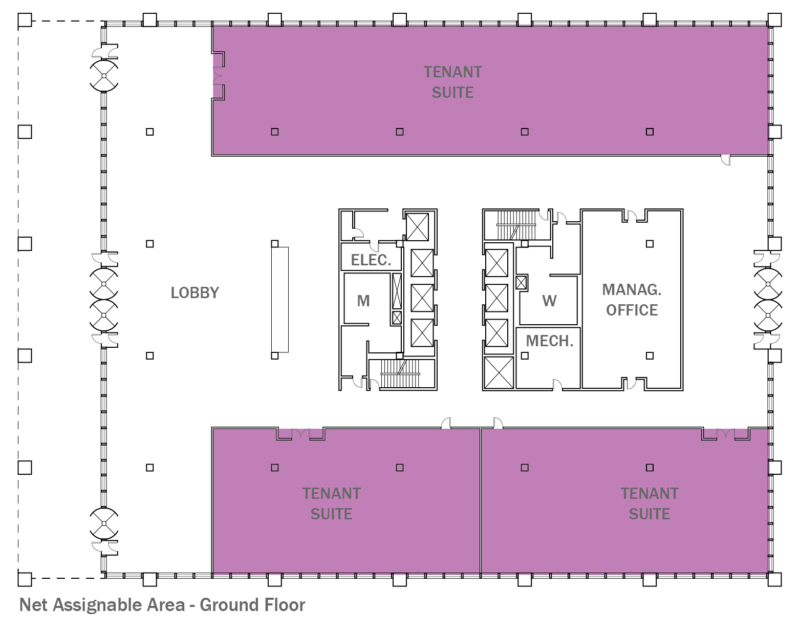
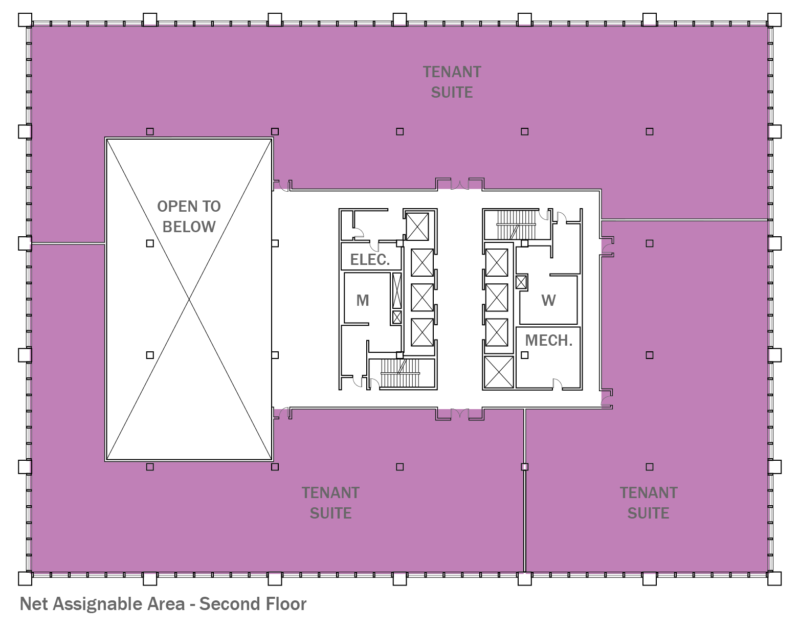
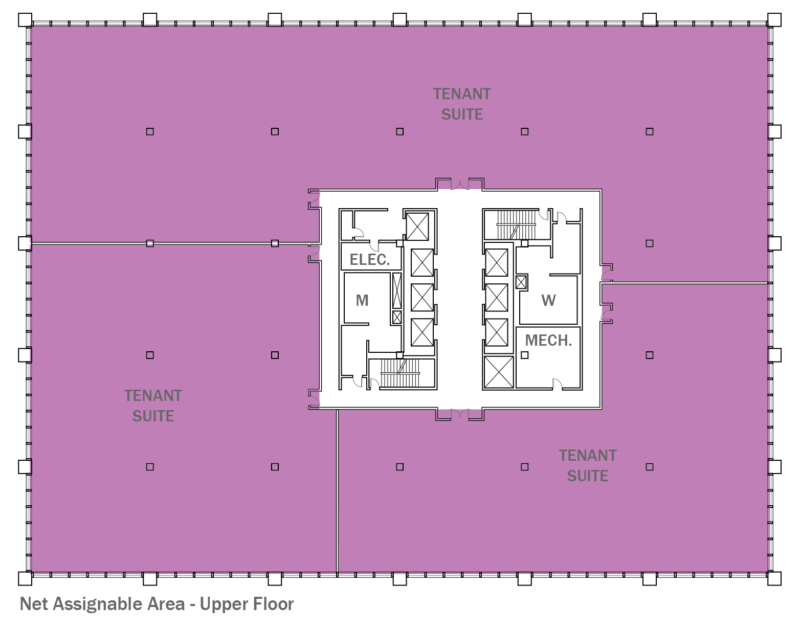
Zoning Floor Area measured as Zoning Gross Square Feet (ZGSF)
Zoning Floor Area is a measurement of a building for the purposes of adhering to a municipality's zoning code. It is established by individual jurisdictions, usually cities or towns. In general, Zoning Area is calculated by determining the gross building area and subtracting certain spaces like mechanical rooms, elevator shafts, stairwells, open atria, exterior balconies, terraces, and other areas as defined in local codes. Since each municipality has their own zoning code, it is important to confirm the local standards prior to making measurements.
FAR, or Floor Area Ratio, is usually calculated as the Zoning Floor Area divided by the total site area. It is used by many municipalities to limit the size of buildings that may be constructed in certain locations. This may also be called a Lot Coverage ratio.


